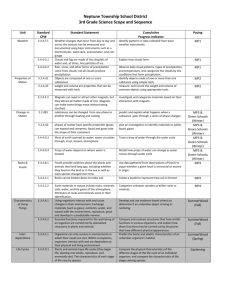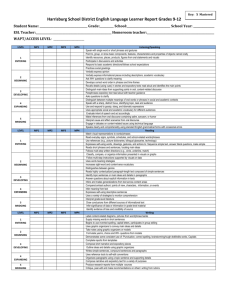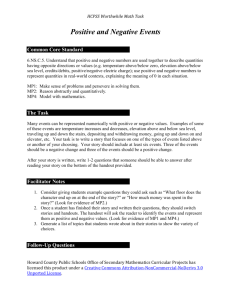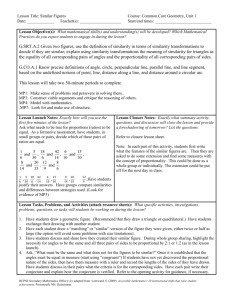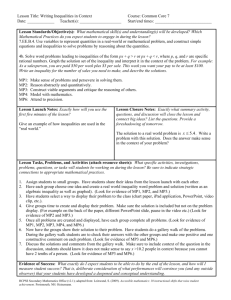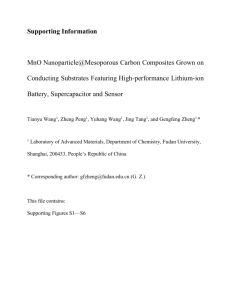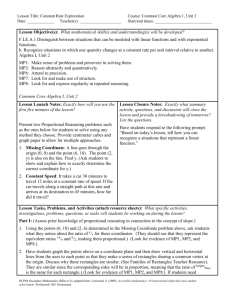MD Voluntary State Curriculum (VSC) with Connections
advertisement
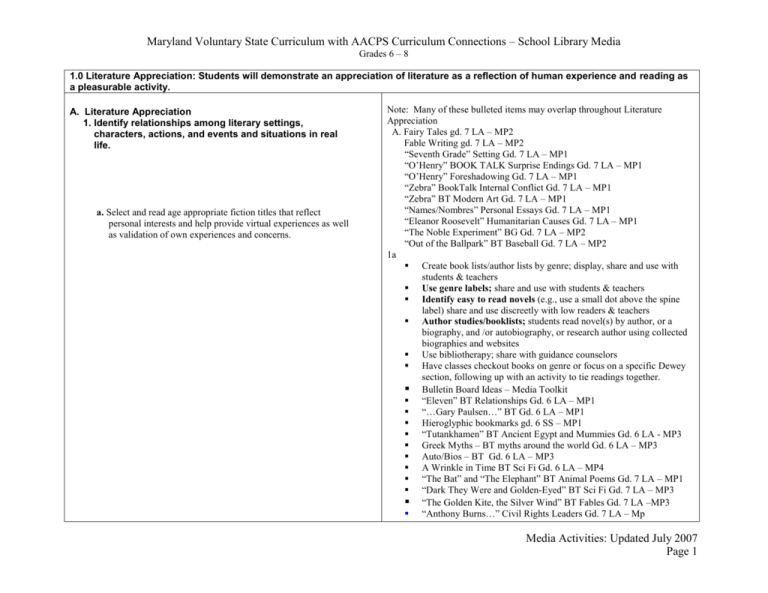
Maryland Voluntary State Curriculum with AACPS Curriculum Connections – School Library Media Grades 6 – 8 1.0 Literature Appreciation: Students will demonstrate an appreciation of literature as a reflection of human experience and reading as a pleasurable activity. A. Literature Appreciation 1. Identify relationships among literary settings, characters, actions, and events and situations in real life. a. Select and read age appropriate fiction titles that reflect personal interests and help provide virtual experiences as well as validation of own experiences and concerns. Note: Many of these bulleted items may overlap throughout Literature Appreciation A. Fairy Tales gd. 7 LA – MP2 Fable Writing gd. 7 LA – MP2 “Seventh Grade” Setting Gd. 7 LA – MP1 “O’Henry” BOOK TALK Surprise Endings Gd. 7 LA – MP1 “O’Henry” Foreshadowing Gd. 7 LA – MP1 “Zebra” BookTalk Internal Conflict Gd. 7 LA – MP1 “Zebra” BT Modern Art Gd. 7 LA – MP1 “Names/Nombres” Personal Essays Gd. 7 LA – MP1 “Eleanor Roosevelt” Humanitarian Causes Gd. 7 LA – MP1 “The Noble Experiment” BG Gd. 7 LA – MP2 “Out of the Ballpark” BT Baseball Gd. 7 LA – MP2 1a Create book lists/author lists by genre; display, share and use with students & teachers Use genre labels; share and use with students & teachers Identify easy to read novels (e.g., use a small dot above the spine label) share and use discreetly with low readers & teachers Author studies/booklists; students read novel(s) by author, or a biography, and /or autobiography, or research author using collected biographies and websites Use bibliotherapy; share with guidance counselors Have classes checkout books on genre or focus on a specific Dewey section, following up with an activity to tie readings together. Bulletin Board Ideas – Media Toolkit “Eleven” BT Relationships Gd. 6 LA – MP1 “…Gary Paulsen…” BT Gd. 6 LA – MP1 Hieroglyphic bookmarks gd. 6 SS – MP1 “Tutankhamen” BT Ancient Egypt and Mummies Gd. 6 LA - MP3 Greek Myths – BT myths around the world Gd. 6 LA – MP3 Auto/Bios – BT Gd. 6 LA – MP3 A Wrinkle in Time BT Sci Fi Gd. 6 LA – MP4 “The Bat” and “The Elephant” BT Animal Poems Gd. 7 LA – MP1 “Dark They Were and Golden-Eyed” BT Sci Fi Gd. 7 LA – MP3 “The Golden Kite, the Silver Wind” BT Fables Gd. 7 LA –MP3 “Anthony Burns…” Civil Rights Leaders Gd. 7 LA – Mp Media Activities: Updated July 2007 Page 1 Maryland Voluntary State Curriculum with AACPS Curriculum Connections – School Library Media Grades 6 – 8 1.0 Literature Appreciation: Students will demonstrate an appreciation of literature as a reflection of human experience and reading as a pleasurable activity. A. Literature Appreciation 1. Identify relationships among literary settings, 1b Work with teacher inserting into lesson characters, actions, and events and situations in real life. 1d Provide background information for lessons/novels (Great Depression; Holocaust); , e.g. develop a PowerPoint with photos, b. Expand use of text-to-text and text-to-world connections maps, facts, etc. to explore the impact works of literature have on readers. “Zebra” Background Vietnam War Gd. 7 LA – MP1 c. Explore techniques authors use to encourage readers to True Confessions of Charlotte Doyle BG Gd. 7 LA – MP2 examine and question their own behaviors and beliefs “The Pasture” and “A Time to Talk” BG Gd. 7 LA – MP2 d. Continue to explore the connection between background “A Long Walk to Freedom” Freedom Fighters Gd. 7 LA – MP4 knowledge and the behaviors and actions of individuals and groups. 1e Provide Dewey classification information, a bibliography and/or pree. Use non-fiction to examine issues and questions related selected books to examine issues being studied. to human experiences throughout history. Hieroglyphic bookmarks gd. 6 SS – MP1 Bibliography citations lesson gd 6 AVID – MP3 OPAC & Career Resources gd. 6 & 8 AVID – MP4 Library of Basra compare LOL ‘One Million Volumes’ gd. 8 LA – MP2 Media Activities: Updated July 2007 Page 2 Maryland Voluntary State Curriculum with AACPS Curriculum Connections – School Library Media Grades 6 – 8 1.0 Literature Appreciation: Students will demonstrate an appreciation of literature as a reflection of human experience and reading as a pleasurable activity. 2. Use libraries to facilitate development of good reading habits. a. Utilize circulation procedures and policies to effectively and efficiently access reading materials. 2a Allow students to place books on hold Advertise/publish the circulation policy to students/staff Encourage walk-ins with pass. Teachers send students on pass during self-selected reading or if finished w/work Open before and after school. Take advantage of after school activity schedule. Lunch pass program Schedule classes regularly for check-out Celebrate reading and books, events, multiculturalism, literary awards, etc., with displays, lessons, PA announcements, PA games or quizzes, etc Use the PA system or CC TV for book promotions during AM announcements. BookTalks–topic: kidnapping (Ransom of Red Chief) gd. 8 LA - MP1 “Eleanor Roosevelt” Time Line Gd. 7 LA – MP1 “Homeless” Info. Poster Gd. 7 LA – MP1 2b b. Choose to browse, select, and enjoy library books. (Method: Work with teachers to provide time for students to interact with books from the library media center.) 3. Experience the pleasure of recreational reading. a. Choose to read independently self-selected books. (Method: Book-talk titles to spark student interest in reading.) (Method: Provide opportunities for readers to discuss with each other books they have read for fun.) (Method: Sponsor reading incentive activities.) (Method: Share experiences from own life demonstrating the pleasure of reading.) 3 Quick & Dirty Poetry Gd. 6 LA – MP2 Create reading area(s) in the LMC Have reading clubs at lunch or after school. Solicit teacher participation. Utilize reading incentive programs: Read Across America, BlackEyed Susan, Bowie Baysox 3a French-speaking Country Flag Research gd.. 6 FL – MP1 Compare FIC & NF bks.(King Tutankhamen/Tut, Tut) gd 7 AVID – MP2 Book Talk Autobiographies gd. 7 AVID – MP2 Model Literature Circles gd. 7 AVID – MP2 Read Aloud Chicken Soup Character lessons gd. 7 AVID – MP2 Media Activities: Updated July 2007 Page 3 Maryland Voluntary State Curriculum with AACPS Curriculum Connections – School Library Media Grades 6 – 8 1.0 Literature Appreciation: Students will demonstrate an appreciation of literature as a reflection of human experience and reading as a pleasurable activity. 3. Experience the pleasure of recreational reading. b. Use age appropriate periodicals for recreational reading. 3b 4. Recognize the connection between reading and being a lifelong learner. Recognize that most periodicals are now for recreational reading not research and order accordingly and allow circulation and use accordingly. To promote the variety of periodicals, conduct a periodical exploratory activity, e.g. a round-robin. If in need of additional popular periodical titles, check with other middle schools to review periodicals that are popular at their schools. Periodicals Introduction Gds. 6,7,8 LA – MP1 Guest Reader – German (Grimm fairy tales) gd. 6 FL – MP1 Seventh Grade BOOK TALK Relationships Gd. 7 LA – MP1 a. Expand their comprehension of the connection between the ability to read and success in daily life. (Method: Continue to share examples demonstrating the importance of lifelong learning and reading in the context of daily life.) (Method: Invite community members to share experiences as lifelong learners and readers in careers and areas of personal interest.) (Method: Provide examples of how fast things are changing and the related need to keep learning new things beyond formal school learning.) b. Practice and apply skills needed to become an independent learner. c. Set goals focusing on aspects of becoming independent, lifelong learners. d. Begin to take ownership of their own learning. 4b Scavenger hunts 4c Exercise: Look into the Future. Dollar bill drawing on overhead projector and split into pieces (CB) 4d Utilize advisory periods and career day activities to incorporate “lifelong learner” concept. Media Activities: Updated July 2007 Page 4 Maryland Voluntary State Curriculum with AACPS Curriculum Connections – School Library Media Grades 6 – 8 2.0 Locate Information: Students will be able to use resources, in a wide variety of formats, to locate information to meet an identified need. A. Locate information 1.a. Demonstrate effective catalog searching beginning with but not limited to 1. Match resources to topic of interest or need. 6th grade orientation. 1.a. When book exchange is scheduled for a class, conduct a 5 minute “search a. Generate more effective searches when using the automated tip” demonstration focusing on a specific catalog feature. catalog. 1.a . Model conducting searches using author, title, subject and keyword. Compare results. Assign or have students determine a search term, use all types of searches, compare results. (I do, We do, You do activity) Repeat these activities using the “Browse” search features and the “Combination” search features. 1.a. Conduct brainstorming activities to develop a list of search terms for a research assignment: keywords, broader terms, narrower terms, synonyms, related terms. 1.a. In research assignments, students use appropriate search features. 1.a Demonstrate how to find genre-based books. 1.a. Science Fair gds. 6,7,8 Science – MP2 OPAC & Career Resources gd. 6 & 8 AVID – MP4 Homecoming BG Gd. 6 LA – MP1 “Primal Compassion” Animal Captivity Gd. 7 LA – MP1 b. Continue to expand use of computer/online resources. 1.b. Provide information about the availability of databases to faculty, students, and parents via Library Media Services Databases brochure, research classes, school newsletter, e-mail, etc. 1.b Conduct in-service opportunities on available databases for faculty 1.b Incorporate on-line resources into student research process, e.g the 7 th grade controversial issue research assignment. 1.b. Provide instruction on advanced searching techniques, e.g., Boolean, asterisk, quotation marks. Compare search results from 2 or more databases. 1.b With the classroom teacher, construct a mini-one-day research assignment based on the use of one specific database. Use such an activity to teach how to use the database. 1 b Magazine gd. 8 Science – MP1 Online Science Current Topic Research – gd. 7 SCI – MP3 Current African Issues Research – g.7 SS – MP4 El Niño current news research gd. 8 SCI – MP3 Capital Punishment Research from LOL ‘The Bet’ gd. 8 LA – MP3 “Offerings at the Wall” Research Vietnam War Gd. 7 LA – MP1 Media Activities: Updated July 2007 Page 5 Maryland Voluntary State Curriculum with AACPS Curriculum Connections – School Library Media Grades 6 – 8 2.0 Locate Information: Students will be able to use resources, in a wide variety of formats, to locate information to meet an identified need. A. Locate information 1. Match resources to topic of interest or need. 1.c Media Scavenger Hunt Gd. 6 LA – MP1– using book catalog to find call number; then using call number to find book on shelf for Ref, Fic, NF, special c. Develop independence in locating relevant materials in all collections. components of the collection. 2. Use concepts related to content of and arrangement on the shelf to select fiction/stories and non-fiction/ information materials to meet current need. a. Increase knowledge of call numbers related to both arrangement on the shelf and appropriate generalizations as to expected content. 1.c OR 2.a. Method: Pathfinder – Students generate list of relevant subject headings/key words for research projects. Students use list to create list of relevant call numbers for browsing collection. Students retrieve relevant books. 2. Trouble River Research & Letter Gd. 6 LA – MP2 Compare FIC & NF bks.(King Tutankhamen /Tut, Tut) gd 7 AVID – MP2 Book Talk Autobiographies gd. 7 AVID – MP2 2.a. Provide adequate labeling of shelves/signage/posters to identify the Dewey classification system. 2.a. In brief activities, connect the call numbers in catalog record to call numbers on shelves and books. 2.a. Students search both the school and public library catalogs for specific preselected subjects. Compare call number results. 2.a. Sixth grade students search both their current school and an elementary feeder school for specific pre-selected subjects. Compare call number results. “Primal Compassion” Animal Captivity Gd. 7 LA – MP1 b. Increase knowledge of advantages and disadvantages of print, non-print and computer/online resources and practice selecting the most appropriate resource for current need. 2.b. Provide students with the opportunity to explore a bogus web site (Google search: “bogus websites”). 2.b. Provide examples of legitimate information needs and several possible resources in varying formats. Students identify advantages/disadvantages of each resource. Compare ‘Flowers of Algernon’ video clips to the LOL story gd. 8 LA – MP3 Media Activities: Updated July 2007 Page 6 Maryland Voluntary State Curriculum with AACPS Curriculum Connections – School Library Media Grades 6 – 8 2.0 Locate Information: Students will be able to use resources, in a wide variety of formats, to locate information to meet an identified need. A. Locate information 3. Students will define and refine an information need by formulating compelling / effective questions. a. Continue to practice developing compelling/ effective research questions. (Method: Provide practice identifying keywords to determine what a question is really asking.) (Method: Provide experiences analyzing what a question is asking and evaluating answers in terms of how well they match what was asked for in the question.) 3a. Science Fair gds. 6,7,8 Science – MP2 “Offerings at the Wall” Research Vietnam War Gd. 7 LA – MP1 3. b. Analyze criteria of assignment to generate compelling/ effective questions. (Method: Have students evaluate sample projects by identifying information they think is missing and suggesting additional information that they would like or need to know about the topic.) (Method: Work with teachers to design assignments involving the use of or generation of compelling/effective questions.) 3.b Method: Model exemplar of finished assignment highlighting/explaining the criteria of the assignment and the questions used to complete it. 3. c. Analyze topics of personal interests to generate compelling/ effective questions. 3.b. Model finished product/exemplar. 3b Science Fair gds. 6,7,8 Science – MP2 3.c. Class brainstorms a list of topics considered to be “current issues”. Conduct a think-pair-share activity to generate effective research questions for selected topics. 3.c Method: Develop guiding question that provides philosophical/instructional relevance to assignment as well as possibilities for follow-up discussion. Media Activities: Updated July 2007 Page 7 Maryland Voluntary State Curriculum with AACPS Curriculum Connections – School Library Media Grades 6 – 8 3.0 Collect Information: Students will be able to collect information relevant to their current information need. A. Collect Information 1. Students will use print resources efficiently and effectively. 1 Invention Research Gd. 6 LA – MP2 “Summer of Fire” Research Gd. 6 LA – MP2 “The Dog of Pompeii” Research Gd. 6 LA – MP3 Invention Research w/brochure Gd. 6 LA – MP3 Index Lesson gd 6 SS – MP1 Ancient Greek Newspaper Research Project gd 6 SS – MP1 Stations - Print and/or Online Research Gds. 6,7,8 any subject area/time French-speaking Country Flag Research gd.. 6 FL – MP1 Water Purification research gd. 7 SCI – MP3 Disease Poster Gd. 7 Health – MP? Country Research w/ brochure product gd. 7 LA/For. Lang – MP4 Dragonwings Research Gd. 7 LA – MP3 Call of the Wild Research Gd. 7 LA – MP4 Invention Research w/Video Product Gd. 7 LA – MP4 Constellation Myths w/art Product Gd. 7 LA/SS/SCI – MP4 Revolution Research & Debate Gd 7 SS – MP4 Bridge Research gd. 7 Tech Ed. – MP 1 WWII William & Mary Research – Gd 8 LA – MP2 Video Making w/MovieMaker & United Streaming Gd. 8 LA - MP3 Civil War Scrapbook Gd 8. SS – MP2 Underground Railroad Quilt Gd 8. SS – MP2 Homestead Act Land claim w/primary docs Gd. 8 SS - MP2 & 4 Rating the Presidents Gd. 8 SS - MP4 Astronomy Research Gd. 8 Science MP1 Compare Primary/Secondary Sources LOL‘Letter to Publisher’ gd 8, LA MP1 Rock Cycle Research & Story – gd. 8 SCI – MP1 Disaster Public Service Announcement – gd. 8 SCI – MP1 Climate Data Research for Summer Camps gd. 8 SCI – MP3 Revolutionary War Patriot Research – Hall of Fame gd. 8 SS MP1 Biography Briefcase – Revolutionary War Gd. 8 SS – MP1 Explorer Biography Suitcase LOL ‘Undaunted Courage’ gd. 8 LA – MP3 Compare Primary/Secondary Sources-Paul Revere ’ gd 8, LA – MP4 Astronomy Career Research gd. 8 SCI – MP4 Media Activities: Updated July 2007 Page 8 Maryland Voluntary State Curriculum with AACPS Curriculum Connections – School Library Media Grades 6 – 8 3.0 Collect Information: Students will be able to collect information relevant to their current information need. A. Collect Information 1. Students will use print resources efficiently and effectively. a. Apply strategies for collecting relevant information from print resources, applying concepts related to access, currency, and accuracy of information. (Method: Review pros and cons of using a print source for locating information to meet specific needs.) 1.a Student centered activity to develop a list of the pros and cons of using print sources for locating information. e.g. “if servers are down, print sources still available” 1.a Using Science content and multiple print sources with a range of copyright dates, compare the CURRENCY of information. 1.a Apply LA pre-reading strategies prior to print research, e.g, parts of the book, format of the text, images, captions. Stress INDEX of multivolume ref. sets, etc. 1.a Use O.H. examples w/ various subjects & their multiple sub-headings for emphasis on index value as idea starter. 1.a ACCURACY: Established authors- show author names/PHD university etc at end of articles. Discuss “fact checkers, editorial staff, “peer review” nature of some sources—Americana etc. 1 a Roll of Thunder Research Gd. 6 LA – MP2 Media Activities: Updated July 2007 Page 9 Maryland Voluntary State Curriculum with AACPS Curriculum Connections – School Library Media Grades 6 – 8 Media Activities: Updated July 2007 Page 10 Maryland Voluntary State Curriculum with AACPS Curriculum Connections – School Library Media Grades 6 – 8 3.0 Collect Information: Students will be able to collect information relevant to their current information need. A. Collect Information 2. Use non-print resources efficiently and effectively a. Choose to use non-print resources when appropriate, applying concepts related to access, currency, and accuracy of information. (Method: Analyze different formats of non-print resources to identify their advantages and disadvantages for use.) b. Continue generating and applying effective search terminology and strategies for using non-print resources. 2. “Ghost of the Lagoon” Research Gd. 6 LA – MP1 “Matthew Henson…” Research Gd. 6 LA – MP1 “Summer of Fire” Research Gd. 6 LA – MP2 “The School Play” BG Gd. 6 MP2 “The Dog of Pompeii” Research Gd. 6 LA – MP3 Ancient Greek Newspaper Research Project gd 6 SS – MP1 French-speaking Country Flag Research gd.. 6 FL – MP1 Chesapeake Bay – Human Impact Research gd 6 SCI - MP4 Stations - Print and/or Online Research Gds. 6,7,8 any subject area/time Dragonwings Research Gd. 7 LA – MP3 Call of the Wild Research Gd. 7 LA – MP4 Invention Research w/Video Product Gd. 7 LA – MP4 Controversial Topic Research w/PowerPoint Product Gd. 7 LA – MP4 Constellation Myths w/art Product Gd. 7 LA/SS/SCI – MP4 Water Purification research gd. 7 SCI – MP3 Carbon/Nitrogen Cycle Research gd. 7 SCI – MP4 Revolution Research & Debate Gd 7 SS – MP4 Country Research w/ brochure product gd. 7 LA/For. Lang – MP4 Bridge Research gd. 7 Tech Ed. – MP 1 Video Making w/MovieMaker & United Streaming Gd. 8 LA - MP3 Revolutionary War Patriot Research – Hall of Fame gd. 8 SS MP1 Biography Briefcase – Revolutionary War Gd. 8 SS – MP1 Civil War Scrapbook Gd 8. SS – MP2 Underground Railroad Quilt Gd 8. SS – MP2 Homestead Act Land claim w/primary docs Gd. 8 SS - MP2 & 4 Model UN Country Research gd. 8 SS – MP3 Rating the Presidents Gd. 8 SS - MP4 Astronomy Research Gd. 8 Science MP1 Disaster Public Service Announcement – gd. 8 SCI – MP1 Climate Data Research for Summer Camps gd. 8 SCI – MP3 College Research w/poster product gd. 8 AVID MP3 Explorer Biography Suitcase LOL ‘Undaunted Courage’ gd. 8 LA – MP3 Compare Primary/Secondary Sources-Paul Revere ’ gd 8, LA – MP4 Astronomy Career Research gd. 8 SCI – MP4 Media Activities: Updated July 2007 Page 11 Maryland Voluntary State Curriculum with AACPS Curriculum Connections – School Library Media Grades 6 – 8 3.0 Collect Information: Students will be able to collect information relevant to their current information need. A. Collect Information 2. Use non-print resources efficiently and effectively a. Choose to use non-print resources when appropriate, applying concepts related to access, currency, and accuracy of information. (Method: Analyze different formats of non-print resources to identify their advantages and disadvantages for use.) b. Continue generating and applying effective search terminology and strategies for using non-print resources. 3. Use computer/online/digital resources efficiently effectively. a. Apply expanded strategies for collecting relevant information from computer/online/digital resources, applying concepts related to access, currency, and accuracy of information. (Method: Expand use of different types of searches using both basic and advanced search modes.) b. Continue generating and applying search terminology and strategies for using computer/online/digital resources. (Method: Address need to generate own search term, provides links to related topics, includes materials related to multiple meanings of term used - ex. colonies returns hits on ants and space as well as political context, etc.) (Method: Continue to provide practice applying concepts related to Boolean searching.) 2.a Student centered activity to develop a list of the pros and cons of using non-print sources for locating information. 2.a Using Science content and multiple non-print sources with a range of copyright dates compare the CURRENCY of information. 2.a Apply LA pre-reading strategies prior to non-print research, e.g. , format of the information, types of images, headings, captions, etc. 2.b Use a Venn diagram to develop search terms. 2.b Apply the same set of search terms in several non-print sources. (Online databases, catalog, search engines, specified web sites.) Compare results. 3.a. Teach students how to use the AACPS catalog’s Combination search. 3.a Apply the combination search strategy in the online databases. Look for their “Advanced” search features. 3.a on-line/digital: Accuracy Discuss difference between acceptance/review by mag./newspaper fact check staffs of articles for accuracy vs. unchecked results list from Yahoo/Google search engine search. Discuss “Wikipedia” currently as “anyone can post anything” under any topic. Demonstration: Ask class members who of them can put up a web page. Model that anyone could put up false info about there favorite sports person and that it could be one of the hits from a search engine search. EFFICIENT/EFFECTIVE: Introduce & use to mastery the Newsbank & Pro Quest Historical databases for appropriate & primary source info retrieval. (7TH & 8TH GRADE ) Practice Boolean terms, options selections on search page. Note choice of relevance #’s or most recent, dependent on their goal, & scan article for BOLDED TERM WITHIN TEXT etc. 3a Invention Research w/brochure Gd. 6 LA – MP3 Egyptian God/Goddess Riddles gd 6 SS – MP1 Earthquake Video LOL - ‘Story of Eyewitness’ gd. 8 LA – MP1 Rock Field Guide Brochure Research – gd. 8 SCI – MP1 Rock Cycle Research & Story – gd. 8 SCI – MP1 College Research w/poster product gd. 8 AVID MP3 Media Activities: Updated July 2007 Page 12 Maryland Voluntary State Curriculum with AACPS Curriculum Connections – School Library Media Grades 6 – 8 3.0 Collect Information: Students will be able to collect information relevant to their current information need. A. Collect Information 3. Use computer/online/digital resources efficiently effectively. b. Continue generating and applying search terminology and strategies for using computer/online/digital resources. (Method: Address need to generate own search term, provides links to related topics, includes materials related to multiple meanings of term used - ex. colonies returns hits on ants and space as well as political context, etc.) (Method: Continue to provide practice applying concepts related to Boolean searching.) 4. Evaluate the content of specific print resources to determine accuracy and relevance of content. a. Apply criteria related to determining authority of author, accuracy, and currency of information to select appropriate print resources to meet current need. b. Apply strategies for determining relevance of information collected in relation to what is asked for in the question. (Method: Provide experiences analyzing what a question is asking and evaluating answers in terms of how well they match what was asked for in the question.) 5. Evaluate the content of specific non-print resources to determine accuracy and relevance of content. a. Apply criteria related to determining authority of author, accuracy, and currency of information to select appropriate non-print resources to meet current need. b. Apply strategies for determining relevance of information collected in relation to what is asked for in the question. 3.0.b Generating Search terminology: Stress that search terminology changes as students go forward in the project, & learn more about the subject, utilizing the more specific terms that appear in the text of articles. Development/recognition of Key Words which narrow focus to a manageable & accurate reflection of question at hand. Show different results from searches in EBSCOhost using 2 terms enclosed in quotes vs. 1 more general term. Ex: “hammerhead shark” vs. shark. Stress problems caused by “natural language” types of searches. 4.a Evaluate Content of specific print sources. Grades 6-8 are taught that project questions are most easily answered through Reference Sources which are seen as Authority Sources and are available in all curriculum areas. Also available at Public Libraries. If introduced and used at School Libraries, students will be more efficient and effective users of reference sources at public libraries as well. Nonfiction to be used for additional information after base of knowledge is gathered. 4.b & 7. Use appropriate graphic organizers A. Students organize their note taking sheets w/ one question at top of page, and one at middle, next question at top of verso side, etc. B. Students re-read their questions to be sure they understand what they’re looking for. Underline the keywords. C. After locating the info in print or online, they read a portion etc. With practice through multiple projects, the students become more adept at this “multi-tasking” process even though many high level skills are required. 4b. Trouble River Research & Letter Gd. 6 LA – MP2 Bridge Research gd. 7 Tech Ed. – MP 1 Anti-Slavery leaders Research gd. 8 LA – MP3 5b. Invention Commercial Gd. 6 LA - MP4 Media Activities: Updated July 2007 Page 13 Maryland Voluntary State Curriculum with AACPS Curriculum Connections – School Library Media Grades 6 – 8 3.0 Collect Information: Students will be able to collect information relevant to their current information need. A. Collect Information 6. Evaluate the content of specific computer/online/ digital resources to determine accuracy and relevance of content. a. Apply criteria related to determining authority of author, accuracy, and currency of information to select appropriate computer/online /digital resources to meet current need. b. Apply strategies for determining relevance of information collected in relation to what is asked for in the question. 7. Use appropriate graphic organizers or note cards to record relevant information. a. Continue use of graphic organizers/note cards, webbing and outlining in print and electronic formats. 6.a To determine authority of adult authors, direct students to look at the bottom of web page, or in text for the professional organization the author is attached to. Currency is noted through text when dates are mentioned, or if online magazine, by the publication date in bibliographic data. Compare Primary/Secondary Sources LOL‘Letter to Publisher’ gd 8, LA MP1 Compare Primary/Secondary Sources-Emancipation packet ’ gd 8, LA – MP4 Compare Primary/Secondary Sources-Paul Revere ’ gd 8, LA – MP4 6.b Relevance: The class (with or w/o support) develop their questions. A relevant source is pre-selected. Distribute the “article” to the class. Have them review questions. Read article, reminding them to keep their questions in mind. Use underlining skills. As a group, ask: does this article give needed info? Which questions does it answer. Write phrase notes to answer the questions. Students see that relevant information can appear in a different order than their questions, but that it still is relevant. 7a Trouble River Research & Letter Gd. 6 LA – MP2 Science Fair gds. 6,7,8 Science – MP2 Country Research w/ brochure product gd. 7 LA/For. Lang – MP4 WWII William & Mary Research – Gd 8 LA – MP2 Civil War Scrapbook Gd 8. SS – MP2 Anti-Slavery leaders Research gd. 8 LA – MP3 Climate Data Research for Summer Camps gd. 8 SCI – MP3 Media Activities: Updated July 2007 Page 14 Maryland Voluntary State Curriculum with AACPS Curriculum Connections – School Library Media Grades 6 – 8 3.0 Collect Information: Students will be able to collect information relevant to their current information need. A. Collect Information 8. Use own words to capture concepts and avoid plagiarism. a. Expand use of technology to facilitate appropriate note taking. (Method: Discuss appropriate types of notes and their functions including summary, paraphrase, list, quotation, observation, dialectic journal, etc.) (Method: Work with teachers to discourage plagiarism and assess all steps in the research process by evaluating notes, rough draft, and bibliography as well as the final product.) 8.a Bridge Research gd. 7 Tech Ed. – MP 1 8.a Big 6/Notetaking w/ Comic Strips gd. 7 Media/LA – MP1 9. Record appropriate bibliographic information to cite sources. a. Use an accepted style sheet for formatting required citations. 9.a Arrange to have the school place a copy of the MLA citation style guide and information concerning plagiarism in the students’ agenda book. Media Activities: Updated July 2007 Page 15 Maryland Voluntary State Curriculum with AACPS Curriculum Connections – School Library Media Grades 6 – 8 4.0 Organize and Manage Data/information: Students will use appropriate print, non-print and computer/online/digital formats to organize and manage data/information. A. Organize and manage data/Information 1. Generate appropriate formats for displaying and managing data/information. a. Record and organize data/information using a variety of different formats; i.e., text, graphs, webs, databases, spreadsheets. (Method: Provide a prompt and discuss the advantages and disadvantages of various formats for displaying the data/ information.) 1.a Teach/Model the use of Index cards, Cornell notes, inspiration, and/or graphic organizers to manage information. Plan multiple mini activities with content teachers to practice. 1.a In a pre-research setting, students will be given a variety of topics and will be asked to identify which format they would use to best display the information. This will be a matching exercise. Topics Football/soccer Animal characteristics Warehouse fire Monthly rainfall School survey Civil War Formats Web Graph Database Spreadsheet Text/Paragraph Climate Data Research for Summer Camps gd. 8 SCI – MP3 2. Interpret data/information displayed in a variety of formats. a. Interpret data/ information presented in a variety of formats. (Method: Provide samples of the same data/information displayed in a variety of formats and discuss the advantages and disadvantages of each in terms of ease of interpretation.) 3. Match appropriate strategy/ format with inherent structure of content to be organized. a. Apply possible strategies for organizing data/information focusing on the significant characteristics of each; i.e., alphabetical, chronological, part to whole, general to specific, main idea and supporting details, compare/contrast, cause and effect, categorizing, etc. 2.a Students working in pairs could display their data/information. Then ask their classmates to critique formats used. 2.a Students use the completed projects of their classmates to answer questions. NOTE: Such questions would have been the basis for the original research on which the projects were based. 2.a Students will be divided into small groups and given large pieces of Paper and markers. Each group will be given two of the aforementioned topics in 1.a. Students will create what they consider the best display format for each of their topics. Students will be asked to create display formats that require little or no explanation. 3.a Provide models of organized information with assignment directions: databases, spreadsheets, PowerPoint, graphs, posters, etc. Allow students to choose appropriate formats. 3.a Consider using software such as “Timeliner”. It can convert information into a presentation format. Images can be used. 3.a For student reference, keep a binder of possible graphic organizers and a computer file of “Inspiration” templates. 3.a Students will be given two sets of index cards. One set will be of the topics mentioned above in 1.a and the other set will be strategies for organizing data. On their table, each group will place the appropriate topic card next to the appropriate strategy. Media Activities: Updated July 2007 Page 16 Maryland Voluntary State Curriculum with AACPS Curriculum Connections – School Library Media Grades 6 – 8 5.0 Interpret Information: Students will be able to interpret information to generate new understandings and knowledge. A. Interpret Information 1. Analyze quality of data, information, and resources. a. Apply strategies to determine ideas being communicated in a story, passage, or segment of a video. (Method: Work with teachers to provide experience for students to identify the intended message of a story, passage or video segment.) b. Apply appropriate strategies to identify evidence of bias or point of view. (Method: Work with teachers to provide experiences for students to identify an author’s point of view or bias as communicated in a story, passage, or video segment.) 2. Apply critical thinking and problem solving strategies. a. Apply strategies for identifying patterns and relationships 1.a Working with an LA teacher use fables (print and video) to determine morals and provide experiences to identify the intended passage. Incorporate several modern day fables like John Scieska’s book, Squids Will Be Squids. .Students write/record their own fable. 1.a Poetry Analysis gd. 7 LA – MP2 Compare ‘Flowers of Algernon’ video clips to the LOL story gd. 8 LA – MP3 1.b Share excerpts from a passage using a variety of authors’ point s of view (consider using “E” books.) Students will determine or identify the bias. 1.b Use examples of literature containing different types of bias and assign groups of students to a biased book. Students examine the book to determine the nature of the bias. Groups explain to the class how the book was biased and if the bias could have, or even should have, been reduced. 1.b Read excerpts from an author’s biography and/or description of the time period in which the author was raised. Students predict what the author’s point of view and/or bias may be when writing literature. Note: Chosen books must reflect the author’s point of view – be aware of the separation between author and speaker. 2. “Primal Compassion” Animal Captivity Gd. 7 LA – MP1 “Ode to an Artichoke” Metaphors Gd. 7 LA – MP2 Fables w/ Conflicting Messages Gd. 7 LA – MP2 “The Golden Kite, the Silver Wind” BT Fables Gd. 7 LA –MP3 Biography Briefcase – Revolutionary War Gd. 8 SS – MP1 2.a-b Using different types of genre model patterns and relationships. 2.a-g Use picture books to create mini-lessons and/or MSA practice activities that address instructional objectives. 2.a. Conduct an ongoing comparison of the countries and cultures around the world. (Gr. 7 SS) 2.a. Compare the organization of reference sources, online databases, search engines and websites. 2.a. Maintain a class log of reoccurring themes in books read. 2 a Poetry & Song Lyrics gd. 7 LA - MP2 Media Activities: Updated July 2007 Page 17 Maryland Voluntary State Curriculum with AACPS Curriculum Connections – School Library Media Grades 6 – 8 5.0 Interpret Information: Students will be able to interpret information to generate new understandings and knowledge. A. Interpret Information 2. Apply critical thinking and problem solving strategies. b. Apply strategies for drawing conclusions. c. Apply strategies for making valid inferences. d. Apply strategies for visualizing. e. Apply strategies for divergent/outside the box thinking. f. Apply strategies for making personal connections with information. g. Apply appropriate strategies to facilitate comprehension, analysis, and synthesis. (Method: Work with teachers to encourage use of activators and summarizers.) 2 b Revolution Research & Debate Gd 7 SS – MP4 Rating the Presidents Gd. 8 SS - MP4 Abstinence Research – Pamphlet product Health - MP1 & 3? Rock Field Guide Brochure Research – gd. 8 SCI – MP1 Say No to Drugs Research and brochure gd 8 Health – MP? 2.b. Present the students with a series of facts and based on those facts, the students must draw conclusions. Plan examples with Science and Social Studies teachers. 2.b. Read passages that incorporate a book’s setting. Students determine what is and is not known about the setting. 2.c Use photographs (see internet/online databases) to teach inference skill. 2.c. Use paragraphs from fiction or reference books and ask the students what is being inferred and how they know 2 c Library of Basra compare LOL ‘One Million Volumes’ gd. 8 LA – MP2 2.d. Dramatize, make visual models, use computer software, practice journaling, and create projects like a word quilt 2.d. Show by example, drama, a poster, using picture books, a visual aid. 2.e. Compare classic fairy tales to modern films. 2.e. Compare a fairytale, e.g., The True Story of The Three Little Pigs and the original version. 2.e. Compare a classic character like Hamlet to a modern figure like Brad Pitt through biographical studies. Capital Punishment Research from LOL ‘The Bet’ gd. 8 LA – MP3 2.f. Connect literature to everyday life through mini booktalks 2 g. Quick & Dirty Poetry Gd. 6 LA MP2 Pass the Poetry Gd. 6 LA – MP2 Poetry Analysis gd. 7 LA – MP2 Bridge Research gd. 7 Tech Ed. – MP 1 Revolutionary War Patriot Research – Hall of Fame gd. 8 SS MP1 Civil War Scrapbook Gd 8. SS – MP2 Anti-Slavery leaders Research gd. 8 LA – MP3 Explorer Biography Suitcase LOL ‘Undaunted Courage’ gd. 8 LA – MP3 Media Activities: Updated July 2007 Page 18 Maryland Voluntary State Curriculum with AACPS Curriculum Connections – School Library Media Grades 6 – 8 6.0 Share Findings/Conclusions: Students will be able to communicate findings/conclusions by producing materials in an appropriate format to support written, oral and multi-media presentations. 1 a. Throughout the year model a variety of appropriate formats for effective A. Share findings/conclusions communication. Provide venues to display, present and publish student products. 1. Make decisions to facilitate effective communication This objective may be included with Task 1 of the Big Six. of ideas. a. Present findings in oral, written, visual, and multimedia formats. Grade 6 Trouble River Research & Letter Gd. 6 LA – MP2 Quick & Dirty Poetry Gd. 6 LA – MP2 Roll of Thunder Research Gd. 6 LA – MP2 Invention Research Gd. 6 LA – MP2 “The Dog of Pompeii” Research Gd. 6 LA – MP3 Invention Research w/brochure Gd. 6 LA – MP3 Shout Outs Gds. 6,7,8 LA – MP4 Invention Commercial Gd. 6 LA - MP4 Disease Wanted Poster Gd. 6 Science MP1 Chesapeake Bay – Human Impact Research gd 6 SCI - MP4 Hieroglyphic bookmarks gd. 6 SS – MP1 Egyptian God/Goddess Riddles gd 6 SS – MP1 Ancient Greek Newspaper Research Project gd 6 SS – MP1 Grade 7 Harris Burdick Writing Activity Gd.7 LA - MP1 “Homeless” info.poster Gd.7 LA – MP1 Poetry & Song Lyrics gd. 7 LA MP2 Fairy Tales gd. 7 LA – MP2 Fable Writing gd. 7 LA – MP2 Invention Research w/Video Product Gd. 7 LA – MP4 Controversial Topic Research w/PowerPoint Product Gd. 7 LA – MP4 Constellation Myths w/art Product Gd. 7 LA/SS/SCI – MP4 Carbon/Nitrogen Cycle Research gd. 7 SCI – MP4 Country Research w/ brochure product gd. 7 LA/For. Lang – MP4 Abstinence Research – Pamphlet product Health – gd 7 MP? Disease Poster Gd. 7 Health - MP1 & 3? Media Activities: Updated July 2007 Page 19 Maryland Voluntary State Curriculum with AACPS Curriculum Connections – School Library Media Grades 6 – 8 6.0 Share Findings/Conclusions: Students will be able to communicate findings/conclusions by producing materials in an appropriate format to support written, oral and multi-media presentations. Grade 8 A. Share findings/conclusions 1. Make decisions to facilitate effective communication WWII William & Mary Research – Gd 8 LA – MP2 of ideas. Video Making w/MovieMaker & United Streaming Gd. 8 LA - MP3 Anti-Slavery leaders Research gd. 8 LA – MP3 a. Present findings in oral, written, visual, and multimedia Capital Punishment Research from LOL ‘The Bet’ gd. 8 LA – MP3 formats. Civil War Scrapbook Gd 8. SS – MP2 Underground Railroad Quilt Gd 8. SS – MP2 Astronomy Research Gd. 8 Science- MP1 Rock Field Guide Brochure Research – gd. 8 SCI – MP1 Rock Cycle Research & Story – gd. 8 SCI – MP1 Beach Changes – MS Moviemaker movie – gd. 8 SCI – MP1 Disaster Public Service Announcement – gd. 8 SCI – MP1 Revolutionary War Patriot Research – Hall of Fame gd. 8 SS MP1 Biography Briefcase – Revolutionary War Gd. 8 SS – MP1 College Research w/poster product gd. 8 AVID MP3 Explorer Bio. Suitcase LOL ‘Undaunted Courage’ gd. 8 LA – MP3 Say No to Drugs Research and brochure gd 8 Health – MP? b. Apply strategies for determining most appropriate format for sharing findings in the context of the current need. (Method: Collaborate with teachers to provide opportunities for students to meet content area outcomes by sharing information orally, in writing, and with visuals.) (Method: Work with teachers to help students make appropriate choices of format for finished products based on the criteria of the assignment, elements of access to technology, and time issues. Suggest consideration be given to purpose of the product, intended audience, planning of content, generation of product, and evaluation of process and product.) (Method: Work with teachers to encourage multiple brief experiences with sharing information, rather than focusing on one major assignment.) Media Activities: Updated July 2007 Page 20 Maryland Voluntary State Curriculum with AACPS Curriculum Connections – School Library Media Grades 6 – 8 6.0 Share Findings/Conclusions: Students will be able to communicate findings/conclusions by producing materials in an appropriate format to support written, oral and multi-media presentations. 2. Apply best practices related to content and layout of presentations. a. Apply strategies for designing layouts that communicate content effectively. (Method: Collaborate with art and computer teachers to expand understanding of best practices related to layout on a page/screen.) (Method: Work with teachers to establish criteria for finished products to emphasize the learning rather than the re-packaging of information.) (Method: Work with teachers to provide opportunities for students to create and evaluate presentations for their effectiveness in communicating ideas and information. Collaborate with teachers and students to develop appropriate rubrics to apply.) 2 a. Have students compare models of oral, written or multimedia products. 2 a. Civil War Scrapbook Gd 8. SS – MP2 Carbon/Nitrogen Cycle Research gd. 7 SCI – MP4 Media Activities: Updated July 2007 Page 21 Maryland Voluntary State Curriculum with AACPS Curriculum Connections – School Library Media Grades 6 – 8 7.0 Ethical Use of Information: Students will demonstrate responsible attitudes toward the use of information. A. Ethical use of information 1. Exhibit respect for the intellectual property rights of others. 1.a. Lessons in putting information into their own words, such as: reading for a. Review and apply strategies for avoiding plagiarism. interest, then, reading slowly for information. Next the students turn the (Method: Work with teachers to design assignments that information over in the middle of the table and writes down everything they facilitate interpretation rather than regurgitation.) remember for a short presentation. Co-taught or low groups are given a “who, (Method: Work with teachers to assess student mastery of what, where, when and how” paper to make notes on for presentation. An all the all steps in the research process, and discourage example to use is the book, The Kid Who Invented the Popsicle for brief plagiarism, by evaluating notes, rough draft, and descriptions of the origins of inventions. If more practice is required, or for more bibliography as well as the final product.) description use the book, The Kid Who Invented The Trampoline. When discussing plagiarism, give examples of people who have plagiarized and what happened to them. Also, talk about the dire consequences of plagiarism as we get older. For reference to real life examples, keep a Vertical File folder of newspaper articles as they appear. 1.a Provide examples of plagiarism and consequences New York Times writer who lost his job Alex Haley and Roots 1.a Provide inservice for teachers/staff 1.a Use school newsletter to make parents aware of problem 1.a Big 6/Notetaking w/ Comic Strips gd. 7 Media/LA – MP1 b. Review and independently apply strategies for complying with fair use and copyright laws. (Method: Discuss copyright issues related to use of digital files as well as print resources. Share examples that are covered in the news to show people do get caught and convicted.) 1.b. Discuss “Nabster” as an example. Media Activities: Updated July 2007 Page 22 Maryland Voluntary State Curriculum with AACPS Curriculum Connections – School Library Media Grades 6 – 8 7.0 Ethical Use of Information: Students will demonstrate responsible attitudes toward the use of information. A. Ethical use of information 1. Exhibit respect for the intellectual property rights of others. c. Apply strategies for citing sources of text and digital information used. (Method: Expand use of standard format for citing sources. Provide examples for different types of sources; i.e., books, encyclopedia and magazine articles, web pages, online resources, interviews, etc.) 2. Utilize safe practices when working online a. Review and utilize safe practices related to sharing personal information and making contacts over the Internet. c Bibliography Puzzles Gd. 6 LA – MP3 Astronomy Research Gd. 8 Science MP1 Bibliography citations lesson gd 6 AVID – MP3 2. a. Review computer use guidelines and encourage students to continue the same guidelines at home. 2 a Review computer guidelines. Do not assume all students know them. 2.a Use newsletter to make parents aware. 3. Utilize freedom of access to ideas. a. Recognize the role of information in a democratic society. 3.a Banned book lesson 3.a Plan with S.S. teacher to incorporate this issue when studying the Bill of Rights in Grade 8. b. Have access to a collection of age appropriate fiction and non-fiction materials. (Method: Share examples of how having access to information have made a difference to individuals.) (Method: Encourage students to use information to make a difference in their own lives.) Media Activities: Updated July 2007 Page 23
